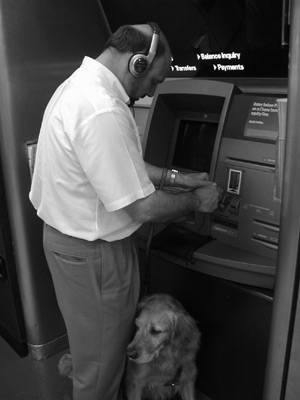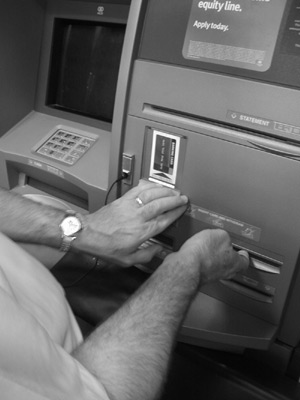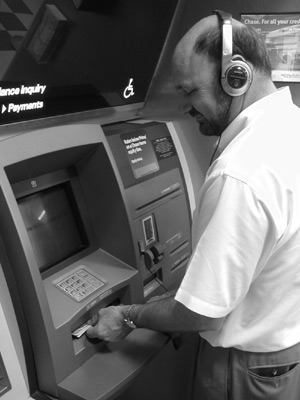An automatic teller machine (ATM) near New York City's historic Union Square made history for Chase (a division of JP Morgan Chase & Co.) in January 2002 as its first talking ATM. Although the ATM offered only the most basic withdrawal, deposit, and balance information functions at that time, it marked the first product of a collaboration between Chase and AccessWorld Solutions, the accessibility consulting department of the American Foundation for the Blind (AFB).
That basic ATM has been honed and polished into a state-of-the-art model with many more features, now known as the Chase eATM. These advanced, accessible machines are currently in place at more than 535 Chase locations in New York and New Jersey, and by the end of 2004, eATMs will be in service in all the bank's 1,735 locations in four states—Connecticut and Texas, as well as New Jersey and New York—according to Kristen Batteria, a Chase spokesperson.
Batteria noted that Chase uses the standard 5575, 5886, and P86 ATMs manufactured by NCR, one of the two major manufacturers of these systems (Diebold is the other). Thanks to usability recommendations by the AccessWorld Solutions team, the Chase eATM uses text-to-speech software for the user interface instead of prerecorded text. The synthetic speech is ViaVoice, manufactured by IBM.
The use of text-to-speech software offers greater flexibility than that of digitally recorded WAV files, the other option used at the talking ATMs of some other banks, according to Janina Sajka, member of the AccessWorld Solutions team and director of technology, research, and development at AFB's Governmental Relations Group in Washington, DC. In contrast to WAV files, which a human reader records and can be changed only in a recording studio, text-to-speech software reads the on-screen text aloud through the speech synthesizer, making it easy to keep information up to date. "It's as easy for the bank to change the information and for all its customers to read it as it is for a blind computer user to use a screen reader," Sajka said.
Part of the AFB team's role was to convince the Chase staff that synthetic speech is about "power and accessibility," not eloquence. Sajka noted that despite the loss of voice and diction, synthetic speech offers more functionality and immediate access to up-to-date information for users who are blind or have low vision.
Caption: Plugging a headset into the Chase eATM.
Caption: Reading braille directions.
AFB also advised that touch-screen access is, in fact, inaccessible to customers who are blind or have low vision, Batteria said, so the Chase eATM provides a standard keypad with keys that are identified by tactile shapes. In addition, the Chase eATM confirms aloud each command or transaction so the user is aware of what is transpiring.
Chase uses keystrokes to confirm the choice of commands. Use of a headset is optional; the customer can listen to the transaction via a built-in speaker. Headphones provide increased privacy and security, of course. To determine whether a Chase ATM is an eATM, customers need only feel for the headset jack a few inches above and to the right of the keypad. You must slide a metal cover upward to expose the jack.
Caption: The payoff!
How It Works
To activate the speech function at an eATM, you press the key sequence 1, 2, 3, Enter. The Enter key is to the right of the 3 key. The instruction to begin with this sequence is not written on the machines in print or in braille, however. You are then offered the opportunity to adjust the volume and rate of speech. Next you receive a verbal description of the machine's layout, including the location of the slots to insert your ATM card and deposit envelopes, as well as those to receive cash and receipts of your transactions. The eATM walks you through the steps for getting cash, finding out the balance for any account, transferring funds, making payments, changing options (such as the amount of "fast cash" you get), and more. While you wait for your transaction to be completed, the machine entertains you with one of a sequence of advertisements about, for example, planning for retirement or purchasing a credit card for your son or daughter who is going away to college.
A Right to Access
Chase is a recent arrival to the growing list of financial institutions that have made their ATMs accessible to customers who are blind or have low vision since 1999. At that time, the first lawsuit was filed against a bank, charging noncompliance with the Americans with Disabilities Act. It was also when San Francisco attorney Lainey Feingold began a series of negotiations that resulted in Wells Fargo installing the first talking ATM in September 1999. Feingold noted that banks are now required to train staff about the availability and use of accessible ATMs, as well as to publicize their availability and locations.
These are areas in which Chase still needs improvement. The ATM locator on the Chase web site has drop-down menus that are difficult to use with a screen reader, and nowhere does the web site mention which ATM locations are eATMs that use text-to-speech software. Moreover, Chase representatives who answered the toll-free customer service number could not provide information on the location of accessible ATMs for customers who are blind or are visually impaired, although they were familiar with which locations are wheelchair accessible. Batteria confirmed that publicizing the eATMS is an area that still needs work.
Feingold, considered by many in the accessibility community to be the mother of talking ATMs, commended Chase for its eATM development and noted: "It's not a matter of usage; it's a matter of people's rights, of their entitlement to this access." A sign of her success in the accessibility battles is simply told: Until recently, Feingold knew by heart all the locations of talking ATMs at various bank branches throughout the United States. Now there are too many for her to remember; in just four years, the number of accessible ATMs, including Chase's eATMS, has grown to 12,000.
For More Information
For more information on eATMs, contact: Chase; e-mail (public relations): <Kristen.Batteria@jpmchase.com>; phone (customer service): 800-CHASE24; web site: <www.chase.com>.


